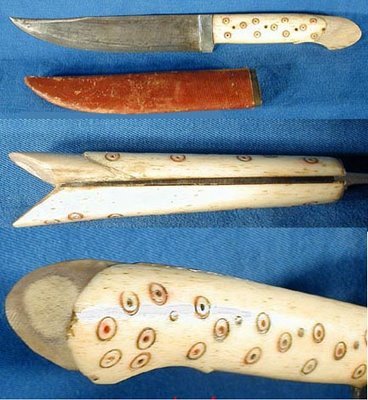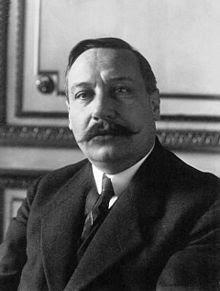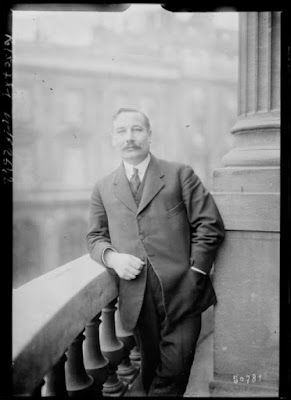Mavi Boncuk |
The Arquebus
Heavy arquebuses mounted on wagons were called arquebus à croc.
These carried a lead ball of about 3.5 ounces (100 g). An infantryman armed with an arquebus is called an arquebusier.
The earliest form of arquebus appeared in Europe by 1411 as a hand cannon with a serpentine lever to hold matches. Around 1470 a shoulder stock was added to the arquebus and in 1475 the matchlock mechanism was added, making the arquebus the first firearm to use a trigger. It is also considered to be the first portable shoulder arms firearm.
The arquebus has at times been known as the harquebus, harkbus, hackbut, hagbut, archibugio, haakbus, schiopo,sclopus, tüfenk, tofak, matchlock, and firelock. The first sure attestation of the term arquebus dates back to 1364, when the lord of Milan, Bernabò Visconti, recruited 70 archibuxoli, although, in this case, the term arquebus may have been used as a synonym for hand cannon. In the early 16th century, the term "arquebus" was used to describe an assortment of guns, but by the late 16th century the arquebus, caliver, and musket had settled down into size categories for firearms.
Continental European powers such as the Spanish, Germans, and French differentiated muskets from arquebuses by size and if they required a fork rest or not. However, the musket – essentially a large arquebus – which had been introduced around 1521, fell out of favor in the mid 16th century due to the decline of armor, but the term stuck around and musket became a generic descriptor for all 'shoulder arms' fireweapons into the 1800s. At least on one occasion the musket and arquebus have been used interchangeably to refer to the same weapon, and even referred to as an "arquebus musket". A Habsburg commander in the mid-1560s once referred to muskets as "double arquebuses". The matchlock firing mechanism also became a common term for the arquebus after it was added to the firearm. Later flintlock firearms were sometimes called fusils or fuzees.
The musket was simply a larger version of the arquebus, with a longer and heavier barrel. Since the barrel was heavier, a typical musketeer would also carry a couple of sticks to rest the end of the barrel on. A musket also has more recoil than an arquebus, therefore its user needed to be correspondingly stronger to withstand this recoil. Specialized troops, such as the Turkish Janissaries, Russian Streltsy and the French Musketeers, were formed to use this weapon. These soldiers were paid more than ordinary soldiers.
Ottoman Use of Arquebus
The Mamluks in particular were conservatively against the incorporation of gunpowder weapons. When faced with cannons and arquebuses wielded by the Ottomans they criticized them thus, "God curse the man who invented them, and God curse the man who fires on Muslims with them." Insults were also levied against the Ottomans for having "brought with you this contrivance artfully devised by the Christians of Europe when they were incapable of meeting the Muslim armies on the battlefield". Similarly, musketeers and musket-wielding infantrymen were despised in society by the feudal knights, even until the time of Cervantes (1547–1616 AD).
Eventually the Mamluks under Qaitbay were ordered in 1489 to train in the use of al-bunduq al-rasas (arquebuses). However, in 1514 an Ottoman army of 12,000 soldiers wielding arquebuses devastated a much larger Mamluk army. The arquebus had become a common infantry weapon by the 16th century due to its relative cheapness – a helmet, breastplate and pike cost about three and a quarter ducats while an arquebus only a little over one ducat.Another advantage of arquebuses over other equipment and weapons was its short training period. While a bow potentially took years to master, an effective arquebusier could be trained in just two weeks.
According to a 1571 report by Vincentio d'Alessandri, Persian arms including arquebuses "were superior and better tempered than those of any other nation", suggesting that such firearms were in common use among middle eastern powers by at least the mid-16th century.
According to a 1571 report by Vincentio d'Alessandri, Persian arms including arquebuses "were superior and better tempered than those of any other nation", suggesting that such firearms were in common use among middle eastern powers by at least the mid-16th century.
The Ottomans also made use of arquebuses. Arquebusiers served in the hundreds in Sultan Murad II's campaign in the 1440s when he crossed Bosporus straits and arquebuses were used in combat by the Ottomans at the second battle of Kosovo in 1448.[61] Ottomans also made some use of Wagon Fortresses which they copied from the Hussite, which often involved the placing of arquebusiers in the protective wagons and using them against the enemy. Arquebusiers were also used effectively at the battle of Bashkent in 1473 when they were used in conjunction with artillery.
Mavzer: Mauser[1] Named after Paul von Mauser German industrialist (1838-1914).
Karabina: carbine EN[2]
Tüfek: from tü root tükürme/spit. rifle EN[3] possibly oldTR tüwek (Çiğil dialect) üfleme borusu ; fromFA tufak/tufang تفك/تفنگ tuf تف [onom.]
tüfek/tüfeng
"uzun namlulu ateşli silah" [ Sinan Paşa, Tazarrûname (1482) ]
ok fışıldusı, yay tınkıldusı, tüfeng patıldusı
Filinta: flintlock rifle EN[4] "ince uzun tüfek" [ Bianchi, Dictionnaire Turc-Français, 1851] from GE Flinte 1. çakmak taşı, 2. çakmaklı tüfek from GE kıymık, taş kırığı.
Misket tüfeği: musket [5]
![]()
Pictured: Ottoman shishana flintlock rifle with tiger walnut stock. Tiger walnut stock inlaid with green and silver, the barrel of highly figured Damascus steel octagonal profile. Length 96cm Length of Barrel 63cm Auction Source
[1] Mauser
Misket tüfeği: musket [5]

Pictured: Ottoman shishana flintlock rifle with tiger walnut stock. Tiger walnut stock inlaid with green and silver, the barrel of highly figured Damascus steel octagonal profile. Length 96cm Length of Barrel 63cm Auction Source
[1] Mauser
type of German army rifle, by 1874; it was introduced 1871, having been invented by brothers Peter Paul (1838-1914) and Wilhelm (1834-1882) Mauser.
After many and most varied experiments, the supreme military authorities of the German empire have now finally decided to supply the whole of the German army--with the exception of the Bavarians, who have a most excellent weapon already in the Werder gun--with a gun of a new pattern, made by a Würtemberg gunsmith of the name of Mauser, who lives at Oberndorf. This new pattern is called the Mauser gun or rifle. This Mauser gun is said to be in every way vastly superior to the chassepot. [G.L.M. Strauss, "Men Who Have Made the New German Empire," London, 1875]
[2] carbine (n.)
short rifle (in 19c. especially one adapted for mounted troops), 1580s, from French carabine (Middle French carabin), used of light horsemen and also of the weapon they carried; it is of uncertain origin, perhaps from Medieval Latin Calabrinus "Calabrian" (i.e., "rifle made in Calabria"). A less-likely theory (Gamillscheg, etc.) connects it to Old French escarrabin "corpse-bearer during the plague," literally (probably) "carrion beetle," said to have been an epithet for archers from Flanders.
[3] rifle (n.) 1775, "portable firearm having a spirally grooved bore," used earlier of the grooves themselves (1751), noun use of rifled (pistol), 1680s, from verb meaning "to cut spiral grooves in" (a gun barrel); see rifle (v.2).
Relate entries & more
rifle (v.1) "to plunder," early 14c. (implied in rifling), from Old French rifler "strip, filch, plunder, peel off (skin or bark), fleece," literally "to graze, scratch" (12c.), probably from a Germanic source (compare Old English geriflian "to wrinkle," Old High German riffilon "to tear by rubbing," Old Norse rifa "to tear, break"). Related: Rifled; rifling.
[4] Flintlock is a general term for any firearm that uses a flint striking ignition mechanism. The term may also apply to a particular form of the mechanism itself, also known as the true flintlock, that was introduced in the early 17th century, and rapidly replaced earlier firearm-ignition technologies, such as the matchlock, the wheellock, and the earlier flintlock mechanisms. French court gunsmith Marin le Bourgeoys made a firearm incorporating a flintlock mechanism for King Louis XIII shortly after his accession to the throne in 1610.[1] However, firearms using some form of flint ignition mechanism had already been in use for over half a century.
The true flintlock continued to be in common use for over two centuries, replaced by percussion cap and, later, the cartridge-based systems in the early-to-mid 19th century. Although long superseded by modern firearms, flintlock weapons enjoy continuing popularity with black-powder shooting enthusiasts.
[5] musket (n.) "firearm for infantry" (later replaced by the rifle), 1580s, from Middle French mousquette, also the name of a kind of sparrow-hawk, diminutive of mosca "a fly," from Latin musca (see midge). The hawk so called either for its size or because it looks speckled when in flight. Early firearms often were given names of beasts (compare dragoon, also falcon, a kind of cannon mentioned by Hakluyt), and the equivalent word in Italian was used to mean "an arrow for a crossbow." The French word had been borrowed earlier into Middle English (late 14c.; c. 1200 as a surname) in its literal sense of "sparrow-hawk."
[5] musket (n.) "firearm for infantry" (later replaced by the rifle), 1580s, from Middle French mousquette, also the name of a kind of sparrow-hawk, diminutive of mosca "a fly," from Latin musca (see midge). The hawk so called either for its size or because it looks speckled when in flight. Early firearms often were given names of beasts (compare dragoon, also falcon, a kind of cannon mentioned by Hakluyt), and the equivalent word in Italian was used to mean "an arrow for a crossbow." The French word had been borrowed earlier into Middle English (late 14c.; c. 1200 as a surname) in its literal sense of "sparrow-hawk."




































































